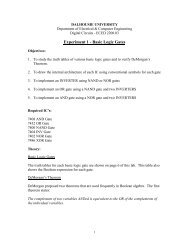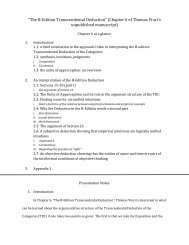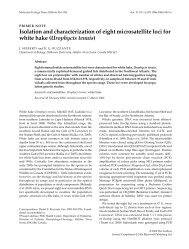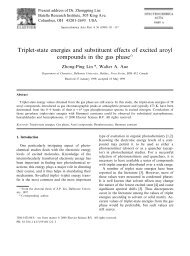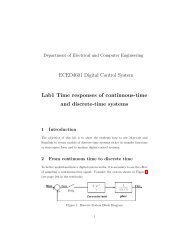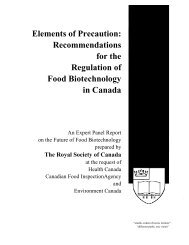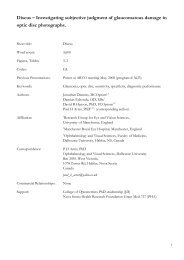2.3. Metapopulations Extinction risk in a ... - Myweb.dal.ca
2.3. Metapopulations Extinction risk in a ... - Myweb.dal.ca
2.3. Metapopulations Extinction risk in a ... - Myweb.dal.ca
You also want an ePaper? Increase the reach of your titles
YUMPU automatically turns print PDFs into web optimized ePapers that Google loves.
<strong>2.3.</strong> <strong>Metapopulations</strong><br />
Conservation of spatially<br />
Structured populations<br />
What characterizes metapopulations?<br />
• Spatially separated subpopulations<br />
• Most often due to spatially<br />
discont<strong>in</strong>uous habitat<br />
– natural spatial heterogeneity<br />
– human-<strong>in</strong>duced habitat fragmentation<br />
• Subpopulations are l<strong>in</strong>ked through<br />
emigration and immigration<br />
• Subpopulations <strong>ca</strong>n go ext<strong>in</strong>ct<br />
without the metapopulation go<strong>in</strong>g<br />
ext<strong>in</strong>ct<br />
Habitat patches<br />
Individuals<br />
Dispersal<br />
RECALL: <strong>Metapopulations</strong><br />
• Populations that have no exchange with other<br />
populations are <strong>ca</strong>lled ‘closed’<br />
• Those which are divided <strong>in</strong>to several<br />
<strong>in</strong>teract<strong>in</strong>g, but spatially separated<br />
subpopulations are <strong>ca</strong>lled ‘metapopulations’<br />
Closed population Metapopulation<br />
<strong>Ext<strong>in</strong>ction</strong> <strong>risk</strong> <strong>in</strong> a<br />
metapopulation<br />
• Previously looked at ext<strong>in</strong>ction <strong>risk</strong> for closed<br />
populations<br />
• When there is a lo<strong>ca</strong>l ext<strong>in</strong>ction <strong>in</strong> a metapopulation<br />
– Ext<strong>in</strong>ct subpopulations <strong>ca</strong>n be re-colonized<br />
– Or rema<strong>in</strong> ext<strong>in</strong>ct<br />
– Or become re<strong>in</strong>troduced by humans<br />
• Frequent lo<strong>ca</strong>l ext<strong>in</strong>ction and re-colonization is<br />
common for many metapopulations<br />
Ext<strong>in</strong>ct<br />
Ext<strong>in</strong>ct<br />
S<strong>in</strong>k<br />
Re-colonization<br />
Source
Spatial correlation<br />
• <strong>Ext<strong>in</strong>ction</strong> <strong>risk</strong> of the metapopulation is <strong>in</strong>fluenced<br />
by how similar (synchronous) environmental<br />
variability is affect<strong>in</strong>g its subpopulations<br />
• If this is very similar, all subpopulations <strong>ca</strong>n go<br />
ext<strong>in</strong>ct at once<br />
• If this is dissimilar, there is a lower <strong>risk</strong> that all<br />
subpopulations crash simultaneously<br />
• Spatial correlation decreases with distance<br />
Re-colonization<br />
Trade-off between dispersal and<br />
spatial correlation<br />
• Dispersal rate decreases with distance, recolonizaton<br />
becomes less probable: HIGHER<br />
overall ext<strong>in</strong>ction <strong>risk</strong><br />
• Spatial correlation also decreases with distance,<br />
synchronous ext<strong>in</strong>ctions become less probable:<br />
LOWER overall ext<strong>in</strong>ction <strong>risk</strong><br />
• Trade-off between dispersal rate and spatial<br />
correlation<br />
• The ‘optimal’ distance between subpopulations<br />
depends on the specific dispersal abilities and<br />
the degree of environmental variability<br />
Dispersal rates<br />
• Another important factor is dispersal<br />
(=migration) rate, which leads to successful<br />
re-colonization, hence reduc<strong>in</strong>g ext<strong>in</strong>ction <strong>risk</strong><br />
• Dispersal rate decreases with distance<br />
• It is measured by the proportion of <strong>in</strong>dividuals<br />
that emigrate to another subpopulation<br />
A<br />
N=10<br />
1<br />
3<br />
B<br />
C<br />
Dispersal Rate A-C=0.1<br />
Dispersal Rate A-B=0.3<br />
Overall Rate = 0.4<br />
Appli<strong>ca</strong>tion : Corridors and<br />
reserve design<br />
• Habitat corridors that connect habitat patches<br />
<strong>ca</strong>n aid dispersal and thereby help to connect<br />
subpopulations<br />
• On the contrary corridors <strong>ca</strong>n dra<strong>in</strong> a population<br />
<strong>in</strong>to s<strong>in</strong>k populations, or <strong>ca</strong>n spread<br />
<strong>ca</strong>tastrophes (e.g. disease, wild fires)<br />
Corridors
Appli<strong>ca</strong>tion: design<strong>in</strong>g reserve<br />
networks<br />
S<strong>in</strong>gle large<br />
….or several small reserves?<br />
• The SLOSS debate is a metapopulation problem.<br />
• Many small have lower ext<strong>in</strong>ction <strong>risk</strong> if dispersal<br />
between them is high and environmental<br />
correlation is low<br />
• But if they are too small, they become vulnerable<br />
to edge effects, environmental, demographic<br />
stochasticity<br />
• Metapopulation model<strong>in</strong>g <strong>ca</strong>n answer the SLOSS<br />
question for specific <strong>ca</strong>ses<br />
Example: spotted owl population<br />
• California spotted owl Strix occidentalis<br />
occidentalis<br />
• Habitat is highly fragmented by logg<strong>in</strong>g and<br />
development<br />
• Spatial structure modeled by <strong>in</strong>corporat<strong>in</strong>g<br />
distance-dependent dispersal and spatial<br />
correlation among population growth rates<br />
• Risk of decl<strong>in</strong>e was ma<strong>in</strong>ly sensitive to the<br />
correlations among growth rates. Increased<br />
correlation <strong>in</strong>creased the <strong>risk</strong> of decl<strong>in</strong>e<br />
• Best conservation strategy: improve population<br />
viability of ‘s<strong>in</strong>k populations’<br />
Source: LaHaye et al. (1994) Journal of Animal Ecology 63:775-785<br />
Example: spotted owl metapopulation<br />
Source: LaHaye et al. (1994) Journal of<br />
Animal Ecology 63:775-785<br />
Summ<strong>in</strong>g up<br />
• Spatially l<strong>in</strong>ked meta-populations often have<br />
lower ext<strong>in</strong>ction <strong>risk</strong> than closed populations<br />
• Individual subpopulations <strong>ca</strong>n be sources or<br />
s<strong>in</strong>ks for the meta-population<br />
• Distance between subpopulations reduces<br />
dispersal and environmental correlation<br />
• Meta-population models are important when<br />
assess<strong>in</strong>g ext<strong>in</strong>ction <strong>risk</strong> of spatially structured<br />
populations<br />
• They <strong>ca</strong>n also help <strong>in</strong> the design of nature<br />
reserves



